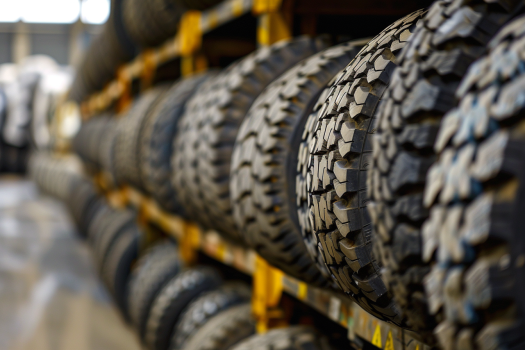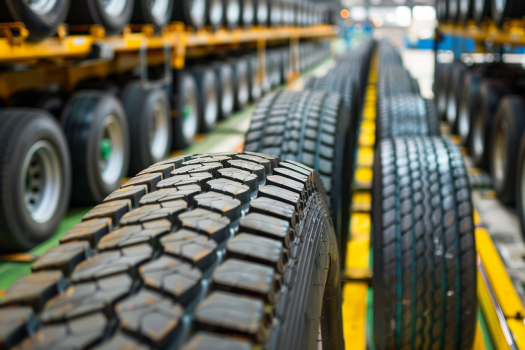Last Updated on August 28, 2024
Navigating the Road to Cost: Unveiling the Secrets Behind Truck Tire Pricing
This in-depth manual explores the aspects affecting truck tire prices as it dives into the complex world of truck tires. This essay seeks to explain why truck tires are a significant investment, covering everything from the complex structure of a tire to the most sophisticated materials used in its manufacture to intricate manufacturing procedures and market dynamics. Come along as we solve the riddles around truck tire prices, providing analysis for fleet managers, industry experts, and anybody else curious about the economics of these crucial parts of the transportation and trucking industries.

The Importance of Truck Tires
Truck tires are more than just components of a vehicle; they are the foundation upon which the trucking industry’s safety, efficiency, and reliability are built. The importance of truck tires must be balanced. These tires are essential to logistics, transportation, and commerce operations since they are made to handle immense weights, lengthy distances, and adverse weather. Road safety, fuel economy, and total transportation costs are all directly impacted by the toughness and performance of truck tires.
Truck tires are built differently, made of different materials, and designed differently than tires for passenger cars. Compared to their passenger counterparts, truck tires are designed to withstand the rigors of commercial operation, which includes towing greater loads and traveling longer distances. Their design and, ultimately, their cost heavily rely on this increased strength and durability demand.
Overview: What Drives the Cost of Truck Tires?
Examining several areas is necessary to comprehend what influences truck tire prices, from the tires’ materials and structure to the dynamics of the market and government regulations. The cost of rubber is only one component of the price of truck tires; other factors also play a role.
- Technology and Materials: Steel, various compounds, and natural and synthetic rubbers are intricately mixed to create truck tires. The cost of the tires is mainly determined by the caliber of these components and the technology used in their mixing and construction.
- Production Method: Manufacturing truck tires entails high labor, quality control, and safety standard compliance costs. This procedure is essential to guarantee that the tires can endure the demands of heavy-duty use.
- Brand and Reputation: Well-known tire brands sometimes command premium costs because they stand for excellence, dependability, and post-purchase support. By making significant R&D investments, these companies help improve tire safety and technology.
- Supply Chain and Distribution: The logistics of getting truck tires from producers to distributors and warehouses raise the final price. This covers processing, shipping, and storage costs.
- Market Forces: Demand, competition, and economic conditions all impact truck tire prices, just like other commodities. These elements may lead to changes in cost.
- Regulatory Compliance: Truck tires must adhere to various regulatory standards, including environmental regulations and safety requirements. Compliance with these standards often entails additional costs in the manufacturing process.
In the following sections of this article, each of these factors will be explored in detail, providing a comprehensive understanding of the elements that contribute to the pricing of truck tires. This insight is essential for professionals in the trucking industry, fleet managers, and anyone interested in the economics of this vital component of the transportation sector.
The Anatomy of Truck Tires
The tires on trucks are vital to the transportation business. Their design and construction quality determine their longevity, safety, and efficiency. This section explores the anatomy of truck tires, highlighting the modern materials and technologies used in their production and their fundamental components.
Understanding Tire Components
Truck tires are technical wonders made up of multiple vital parts that work together to enhance their overall longevity and performance.
- Treads: The portion of the tire that makes direct contact with the road is called the tread. Its patterns change based on the tire’s intended application (e.g., long-haul, regional, off-road), and it is made for durability and traction. The tread design influences the tire’s grip and water-ejection capacity, which helps ensure safe handling in various weather scenarios.
- Sidewalls: The sidewalls shield the tire’s internal components and give it lateral stability. They are designed to withstand collisions and abrasions. The sidewall’s elasticity is essential for absorbing shocks for a smoother ride.
- Beads: The rubber-coated steel cables that secure the tire to the rim are called beads. The tire’s structural integrity depends on its beads, which keep it firmly attached to the wheel even when driving quickly and at high speeds.
- Carcass: Also referred to as the body ply, the tire’s carcass serves as its base. Plies, which are cloth or steel cord layers, provide the tire’s strength and form. The carcass must be strong enough to withstand enormous loads and internal forces.
- Belt System: Usually made up of steel layers, the belt system is located between the tread and the carcass. This technique improves puncture resistance, reduces heat accumulation, and stabilizes the tire’s structure.
Advanced Materials and Technology in Tire Manufacturing
Continuous advancements in materials and manufacturing technologies mark the evolution of truck tires.
- Synthetic Rubber Compounds: Modern truck tires combine artificial and natural rubber. Synthetic rubbers provide higher qualities like traction, increased durability, and superior stability at elevated temperatures.
- High-Tensile Steel Cords: High-tensile steel cords strengthen and make the tire’s carcass and belts durable. Under large loads, these components help the tire retain its structural integrity and shape.
- Silica-Enhanced Compounds: A relatively new development in tire compounds is the addition of silica. Rolling resistance is decreased by silica, increasing fuel efficiency and lowering greenhouse gas emissions.
- Creative Tread Designs: Advances in tread technology result in tires that wear more evenly and last longer. These solutions improve performance and safety by being customized to particular road conditions and usage patterns.
- Innovative tire Technology: A new trend in truck tires is integrating intelligent technology. Tire sensors allow for real-time temperature and pressure monitoring, which helps with upkeep and extends tire life.
The complex structure of truck tires is evidence of highly developed materials science and engineering. Understanding these components and the technologies involved in tire manufacturing helps explain the cost of truck tires and underscores their value in the trucking industry. As we explore the factors influencing tire pricing, it becomes evident that each element of a truck tire’s design and construction plays a crucial role in its pricing and performance.
The Manufacturing Process
The process of manufacturing truck tires is complex and laborious. It combines cutting-edge technology with exacting quality and safety requirements. This section explores the fantastic method of creating a truck tire, starting with the design and ending with the final manufacture.
From Design to Production: The Journey of a Truck Tire
Creating a truck tire combines engineering expertise and innovative manufacturing techniques in the dynamic and demanding trucking world. “From Design to Production: The Journey of a Truck Tire” is our exploration, which takes you on a fascinating tour into the core of the tire industry. This section explores the complex process that starts with tire conception and continues through tire manufacturing. Here, we examine the challenges of creating a tire that satisfies exacting performance requirements and the cutting-edge technologies needed to make these designs a reality.
1. Design and Development:
- Conceptualization: The process starts with the tire’s conception, during which engineers and designers describe the tire’s features, applications, and performance requirements. This stage entails intensive research and development to innovate and enhance tire performance.
- Material Selection: Choosing suitable materials is an essential component of design. This entails determining the proper ratio of natural to synthetic rubber, selecting steel cables and cloth for the tire’s carcass, and selecting additional materials.
- Prototype Development: After the design is completed, prototypes are made. These prototypes undergo a thorough testing process to fulfill the required performance standards.
2. Manufacturing Process:
- Mixing and Compounding: The raw materials are combined in the first stage of manufacture. Rubber, fillers, and other chemicals are mixed in sizable mixers to make a uniform composition.
- Assembling the tire: The inner liner is the first component of the tire, followed by plies, beads, sidewalls, and treads. Every element is positioned and formed with precision.
- Molding and Curing: The final form of the tire, including the tread pattern and sidewall marks, is applied to it by placing it in a mold. After that, the tire is heated under pressure (curing), which vulcanizes the rubber and gives it strength and durability.
3. Inspection and Testing:
- Quality Control: Every tire undergoes a comprehensive quality control inspection, which includes eye examinations, X-rays, and computerized tests to look for flaws or irregularities.
- Performance Testing: Tires undergo various tests before being put on the market to ensure they meet safety and performance requirements.
Quality and Safety Standards in Manufacturing
The vital significance of these factors in manufacturing truck tires is emphasized in the “Quality and Safety Standards in Manufacturing.” In this investigation section, we examine the strict guidelines and rigorous testing that truck tires undergo to ensure they are reliable, effective, and safe for the demanding needs of the trucking business. In addition to describing the cutting-edge technologies and legal requirements that support responsible tire manufacturing, this part highlights the tire makers’ dedication to maintaining the highest quality and safety standards.
1. Conformity with Standards:
Truck tires must meet several industry and regulatory standards to be safe for use on public roads. These specifications address environmental impact, speed rating, and load capacity.
2. Innovations in Safety:
- Continuous innovation in manufacturing processes and materials contributes to the safety of truck tires. This includes the development of wear-resistant treads, stronger sidewalls, and improved bead designs.
- Advanced technologies, such as 3D modeling and computer simulations, are used in the design phase to enhance the tires’ safety features before being physically tested.
3. Environmental Considerations:
- Environmental responsibility is a significant aspect of the manufacturing process. This includes reducing waste, optimizing energy use, and minimizing production’s carbon footprint.
- The industry is also moving towards sustainable materials and processes, such as using recycled materials and developing more fuel-efficient tires.
Factors Influencing Tire Prices
Truck tire prices are influenced by various elements, each of which raises the overall cost considerably. This section delves into the main factors influencing tire prices, with particular attention paid to labor and raw materials costs, the impact of R&D, and production expenses.
Raw Material Costs: A Deep Dive
The cost of raw materials used in tire manufacturing is a substantial factor in the overall pricing of truck tires. These materials include:
- Natural and Synthetic Rubber: Both are the primary materials used to make tires. Several factors influence realistic rubber pricing, including changes in the worldwide market, weather patterns that impact rubber plantations, and political developments in major rubber-producing nations. Because it is made of petroleum, synthetic rubber is likewise affected by changes in oil prices.
- Steel and Fabrics: The steel wires used in the bead and reinforcement belts and the synthetic materials used for the carcass, such as nylon and polyester, significantly increase the cost. Global steel and textile market developments affect these materials’ prices.
- Chemicals and Additives: Various chemicals, including sulfur, silica, carbon black, and other additives, are essential to the production of tires. These additives enhance tire characteristics, including strength, longevity, and resistance to temperature changes and wear.
Labor and Production Expenses
The manufacturing process of truck tires is labor-intensive and requires significant capital investment. Key aspects include:
- Skilled Labor: Specialized labor is needed to produce truck tires accurately. Region-to-region variation in labor costs has a direct bearing on manufacturing costs.
- Energy Use: Producing tires requires a lot of energy, especially during curing. The efficiency of the manufacturing facility and local energy prices can impact the energy cost.
- Maintenance and Equipment: Maintaining the facilities and machinery used in tire production is expensive. The high-tech machinery requires periodic upgrades and routine maintenance to maintain optimal operation.
Research and Development: Innovations in Truck Tires
Research and development (R&D) is critical in the tire industry, leading to innovations that improve tire performance and safety. The costs associated with R&D include:
- Innovative Design and Materials: Research funding is required to create novel tire designs and incorporate cutting-edge materials. This involves testing novel compounds and materials to improve tire properties, including longevity, load capacity, and fuel efficiency.
- Environmental and safety regulations include creating tires with less rolling resistance to reduce emissions and improve fuel economy.
- Innovative Manufacturing Methods: Developing novel manufacturing procedures reduces waste and improves efficiency. This includes incorporating sophisticated technologies and automation into the industrial process.

The Role of Brand and Reputation
A tire manufacturer’s brand and reputation can significantly influence pricing in the truck tire market. This section examines the role of branding, differentiating between premium and budget tire options, and how these factors affect tire pricing.
How Branding Influences Tire Pricing
The influence of branding on tire pricing extends beyond the physical product to encompass the perceived value and trust associated with a brand.
- Perceived Value: Consumers often perceive premium brands as offering higher value, associating them with quality, reliability, and advanced technology. This perception allows premium brands to command higher prices.
- Marketing and Advertising: Premium brands invest more in marketing and advertising, creating a brand image that resonates with quality and reliability. These costs are factored into the pricing of their tires.
- Expectations and Customer Loyalty: Well-known brands have devoted followers of customers who are prepared to pay extra for guarantees of excellence and performance. Years of satisfying experiences have developed this loyalty, which affects pricing policies.
- Warranties and Services: To increase the entire value of their products, premium tire brands frequently provide extensive warranties and customer service. Although these services increase consumer happiness, they also drive up tire costs.
The Impact of Logistics and Distribution
Logistics and distribution are essential in determining the product’s final price in the truck tire industry. This part of our comprehensive analysis focuses on how the supply chain dynamics and the global market influence tire pricing.
Navigating the Supply Chain: Costs and Challenges
The truck tire supply chain is a complicated and multifaceted system that includes expenses and difficulties at every level, from purchasing raw materials to delivering the completed product.
- Raw Material Sourcing: Purchasing raw materials (steel, rubber, etc.) necessitates interacting with international suppliers, which might impact trade regulations, geopolitical issues, and the cost of shipping.
- Production & Manufacturing: The location of manufacturing facilities significantly influences cost. Production expenses depend on several factors, including labor costs, energy prices, and the accessibility of raw materials.
- Transportation and Shipping: The cost of transporting tires from the factory to warehouses and distributors adds to the overall expense. This includes freight charges, fuel costs, and the complexities of managing logistics over long distances, often across borders.
- Inventory Management: Warehousing costs, including storage, handling, and inventory management, contribute to supply chain expenses. Efficient inventory management is crucial to reducing these costs and ensuring timely delivery.
- Regulatory Compliance: Compliance with various international trade regulations and customs duties adds another layer of complexity and cost to the supply chain.
The Role of Global Markets in Tire Pricing
The pricing of truck tires is also significantly influenced by the dynamics of the global market:
- Global Demand and Supply: Price swings may result from an imbalance between the supply and demand for truck tires worldwide. For example, price cuts may result from overproduction in one place and price increases in another due to a spike in demand.
- Currency Fluctuations: Currency fluctuations can affect costs because the tire industry is international. Exports from the producing nation may be more affordable if their currency is weaker, conversely, if it is more robust.
- Foreign Trade Regulations: Tariffs, trade agreements, and embargoes can all significantly affect the price of tires. For instance, tire tariffs may increase prices in the importer nation.
- Competition: The global rivalry between tire manufacturers impacts pricing methods. In marketplaces where there is more competition, prices are usually more competitive.
How Performance Factors Affect Pricing
The performance attributes of truck tires, such as load capacity, fuel efficiency, and adaptability to different road conditions, significantly impact their pricing.
- Load Capacity and Stability: The more expensive tires can carry larger loads without sacrificing safety or stability. This flexibility is essential for commercial trucks that operate in various load circumstances.
- All-Weather Performance: Tires that withstand weather conditions, such as rain, snow, and sunshine, are frequently more expensive. The materials and technology needed to accomplish this adaptability raise the price.
- Features for Safety: Safety-enhancing characteristics, such as increased grip and reduced stopping distances, are essential performance factors that affect tire cost. Manufacturers make significant R&D investments to create tires with the highest level of safety.
- Specialized Tires for Specific Applications: Tires designed for specific applications, such as off-road or long-haul trucking, often have unique features tailored to those conditions. The technical design and technology required for these tires can increase their cost.
Legal and Regulatory Factors
Like many others, the truck tire industry is subject to various legal and regulatory factors that significantly influence pricing. These factors include environmental and safety regulations, tariffs, and trade policies. Understanding these influences is crucial for consumers and industry professionals alike.
Compliance Costs: Environmental and Safety Regulations
Environmental and safety regulations profoundly impact the truck tire manufacturing process, affecting cost and design.
Environmental Regulations:
- Manufacturing costs may rise in response to regulations designed to lessen tires’ environmental impact, such as restricting emissions during production or mandating the use of specific materials.
- Initiatives involving significant R&D investments, such as promoting tires with lower rolling resistance to cut fuel consumption and CO2 emissions, may impact tire pricing.
Safety Regulations:
- Safety requirements mandate numerous characteristics of tire design, like load capacity, wear resistance, and tread depth. Cutting-edge materials and manufacturing processes are frequently necessary to meet these demands.
- Compliance with safety rules guarantees that the tires fulfill the minimal performance standards, which may result in elevated production expenses because of superior materials and advanced manufacturing techniques.
The Impact of Tariffs and Trade Policies on Tire Prices
Tariffs and trade policies significantly determine the final cost of truck tires in various markets.
Tariffs:
- Import tariffs on tires can significantly increase the cost for consumers in the importing country. These tariffs are often used to protect domestic manufacturers from foreign competition.
- The fluctuation of tariff rates, often driven by political and economic factors, can lead to price instability in the tire market.
Trade Policies:
- Free trade agreements and regional trade policies can lower the cost of tire imports by reducing or eliminating tariffs, thus affecting tire prices in those markets.
- Trade disputes and retaliatory tariffs can lead to increased costs and supply chain disruptions, impacting the availability and pricing of tires in affected markets.
Making an Informed Choice
Selecting the right tires for a truck is a critical decision that impacts safety, efficiency, and cost-effectiveness. Understanding tire specifications and ratings and having a set of practical tips can significantly assist truck owners and operators in making an informed choice. This section offers guidance on deciphering tire specifications and tips for choosing the most suitable tires for specific trucking needs.
Deciphering Tire Specifications and Ratings
Truck tires are rated and specified differently, indicating their appropriate applications. Knowing these will aid in choosing the proper tire:
- Tire Size and Load Rating: Tire length is typically represented by a string of digits and characters (e.g., 225/70R19.5). The load rating indicates the maximum weight the tire can securely support. Selecting tires that meet the truck’s size and load specifications is critical.
- Speed Rating: A tire’s speed rating denotes the highest speed at which it is safe to carry a load under particular circumstances. Even though trucks don’t usually drive fast, selecting tires with the correct speed rating is crucial for overall performance and safety.
- Tread Pattern: The tread pattern affects the tire’s traction and performance in different weather conditions. For example, tires with deeper grooves are generally better in wet conditions, while those with a closed-shoulder design can be more efficient for highway use.
- Tire Type: Tires are designed for different applications, such as long-haul, regional, urban, or off-road use. Selecting the right type based on the truck’s primary use is essential.

Tips for Choosing the Right Tires for Your Truck
Making the right tire choice involves more than understanding specifications; it requires a holistic approach considering various aspects.
- Evaluate Your Truck’s Needs: Consider your truck’s usual loads, travel distances, and the roads you drive regularly. This evaluation will help you select the tires best suit your truck’s operation.
- Think about fuel efficiency: Tires with reduced rolling resistance can considerably decrease fuel expenses. This is especially crucial for long-haul trucks that are driven for extended periods.
- Place Safety and Performance First: Seek tires with ratings for durability, braking effectiveness, and grip. Buying high-quality tires can improve safety and lower the risk of tire-related accidents when driving.
- Check Warranties and After-Sales Services: Consider the manufacturer’s warranty and the availability of after-sales services. These factors can indicate the quality and reliability of the tires.
- Seek Expert Advice: If in doubt, consult tire professionals who can provide recommendations based on your requirements. They can also offer insights into the latest tire technologies and trends.
- Budget Considerations: While it’s tempting to opt for cheaper options, consider the total cost of ownership, including factors like longevity, fuel efficiency, and potential downtime due to tire issues. Sometimes, investing more upfront can save money in the long run.
Conclusion & Recommendations
As we conclude our thorough examination of truck tire pricing, it is evident that various factors influence these crucial parts’ final costs. Every factor, from cutting-edge materials and production techniques to the impact of brand reputation and worldwide market dynamics, is essential in determining the cost of truck tires. Making educated judgments and ensuring truck owners and operators can successfully traverse the market requires understanding these elements.
Summarizing the Cost Factors of Truck Tires
Upon concluding our detailed analysis of truck tire prices, it is apparent that numerous factors impact the ultimate cost of these essential components. Every element plays a critical role in deciding the price of truck tires, from state-of-the-art materials and manufacturing processes to the influence of brand reputation and global market dynamics. Understanding these factors is necessary to make informed decisions and guarantee that truck owners and operators can successfully navigate the market.
Looking Ahead: The Future of Truck Tire Pricing
The truck tire market seems set up for continued development in the future. Technological advancements, changes in the worldwide market and regulatory environments, and other factors imply that truck tire prices will continue fluctuating. Technological developments may influence future cost structures due to the growing emphasis on efficiency and sustainability. Truck owners and operators need to keep up with these advancements so they may modify their purchasing strategies appropriately.
Selection Of Truck Tires
Having a trustworthy and experienced tire provider by your side can help you navigate the complexity of truck tire pricing and choose the best option for your truck. Tires Easy Truck offers a wide range of truck tires suitable for different budgets and purposes. Our in-depth industry knowledge guarantees that you receive a tire and a solution that satisfies your unique value, performance, and safety needs.
Easy Truck provides the tires you need, whether you’re searching for long-lasting, durable solutions for long hauls or specialized options for particular terrains. We provide products from top manufacturers so that you can ensure their quality and dependability. Finding the ideal tire is a simple and knowledgeable procedure with the help of our user-friendly website and knowledgeable support staff.
Find Your Perfect Truck Tire Today
As you venture forward in the trucking world, let Tires Easy Truck be your trusted companion in selecting the ideal tires for your fleet. Click the link above to explore our selection and take the first step towards optimized performance and cost-efficiency on the road.
FAQs
Why are truck tires so expensive?
Truck tires are expensive due to their complex manufacturing process, high-quality materials, and the technology required to ensure durability, safety, and efficiency. They are designed to withstand heavy loads and long distances, necessitating a higher research and development investment than regular passenger vehicle tires.
How much should a truck tire cost?
The cost of a truck tire varies considerably based on type, size, brand, and specific features. A standard commercial truck tire can range from $300 to $600 on average. However, specialized or premium brands may cost more.
Will tires go down in price?
Tire pricing is subject to market conditions, raw material costs, and global economic factors. While it’s difficult to predict with certainty, prices may fluctuate based on changes in these factors. Currently, no definitive trend indicates a significant decrease in tire prices.
How much do tires cost in 2024?
As of 2024, the cost of truck tires continues to be influenced by factors like brand, type, and market conditions. Prices can range widely, but on average, commercial truck tires are priced between $300 and $600 each, with specialized or high-end models costing more.
What is an economy tire?
An economy tire is designed to be more affordable, offering essential performance and safety features suitable for standard driving conditions. These tires typically have a lower price point and are cost-effective for those prioritizing budget over advanced features or extended durability.
How much do tires affect fuel economy?
Tires can significantly impact fuel economy. Low-rolling-resistance tires are designed to reduce the energy lost as heat when a tire rolls down the road, thereby improving fuel efficiency. It’s estimated that the right choice of tires can improve a vehicle’s fuel economy by 3% to 5%.
Why are truck tires so expensive?
Truck tires are expensive because they are built to handle extreme conditions, including heavy loads, long-distance hauls, and varied terrain. The cost reflects the advanced materials, rigorous testing, and specialized designs that ensure their durability and safety.
What is the value of truck tires?
The useful life of truck tires varies based on usage, maintenance, and driving conditions. A well-maintained truck tire can last between 3 and 6 years or approximately 70,000 to 125,000 miles. Regular inspections and proper tire care can extend their lifespan.











 English
English Français
Français Español
Español